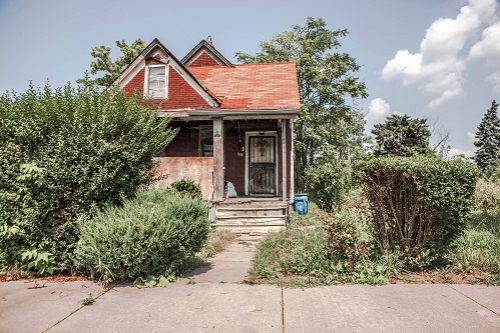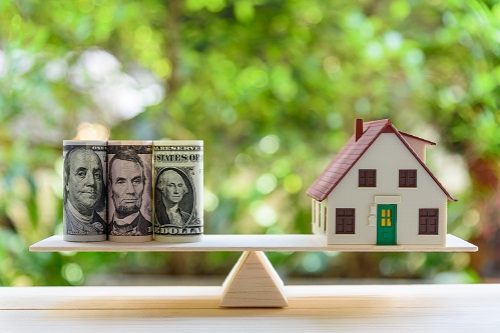- What is replacement cost?
- How to calculate the replacement cost of your home
- Home replacement cost calculator
- Using a home replacement cost estimator
- What is replacement cost coverage for homeowners insurance?
- Replacement cost vs. actual cash value
- What is the 80/20 rule for replacement cost?
- Replacement cost value vs. market value
- What an independent appraiser uses to create a home replacement cost calculation
- What factors affect the replacement cost of your home?
- When should you update your replacement cost estimate?
- Avoid under-insuring your home: Expert advice
- Replacement cost insurance coverage: Our recommendations
- FAQ: Replacement cost calculation
What is replacement cost?
Replacement cost is how much it would cost to rebuild your house using materials of like kind and quality at today's prices.
Insurance companies use a calculation of your home's replacement cost value to determine the amount of dwelling coverage on your policy. It's the maximum amount your insurance company will pay to replace your home.
How to calculate the replacement cost of your home
There are three methods, with varying degrees of cost and accuracy, to estimate replacement cost. Here's an overview.
| Method | Accuracy | Cost | Timeline |
|---|---|---|---|
| Appraisal | High | $200-$600 | Several days |
| Insurance company calculator | Moderate-High | Free | Less than an hour |
| DIY calculation | Low | Free | Minutes |
Most people use the calculation done by the insurance company to determine replacement cost.
“Typically, a cost estimator for the dwelling should be done by an agent,” Kristofer Kirchen, president of Advanced Insurance Managers, says. However, since many people don’t use agents these days, it may also be done on the company website or by a representative over the phone.
If you disagree with the number or just want to verify it's correct, you can do it yourself. In this case, it’s best to hire a professional appraiser.
Below are some of the steps you can take to determine the replacement cost of your home.
We'll use the example of homeowners we'll call the Lee family to illustrate.
Get an appraisal. You can hire a professional to appraise your home's value. This will be an expert who will come to your home and inspect it. A good appraiser will be familiar with ordinances that apply in your area, and will understand local building costs.
The Lees hire an appraiser to determine the replacement cost of the home. The appraiser visits the home, evaluates its construction, features and fixtures, and comes up with an appraised home replacement cost of $407,000.
Estimate the replacement value on your own. You can also use a DIY approach by using a home replacement cost calculator. Remember, this figure is only a loose estimate and should be seen as a starting point, not the final amount.
The Lees contact a local construction company, where they learn that the average cost per square foot in their area is $175. Their home is 2,100 square feet, so they multiply that by $175, and come up with a reconstruction cost of $367,000.
Understand key replacement cost factors. When estimating your home’s replacement cost, it is important to know details about the home, including its location, age and square footage. You also should know which types of fixtures and features the home has and the cost of labor in your area.
Because their home has high-end features, including granite countertops, maple cabinets, and hardwood floors, the Lees know that it will likely cost more to rebuild than the average. They need more coverage than the estimate.
Get a replacement cost estimate and quote from your insurance company. Insurance companies use proprietary software to calculate the replacement cost of your home based on the information you provide to them. This may not be quite as accurate as an appraisal, where an expert examines the home, but will be more accurate than an estimate.
The insurance company calculates the replacement cost at $399,000. The Lees would prefer to match the appraiser's number, so they add an extended replacement cost coverage endorsement. The endorsement includes 125% replacement cost coverage, which adds an additional $99,750.
Their policy will therefore have dwelling coverage of: $399,000 x $99,750 = $498,750.
This offers enough coverage to match the appraiser's calculations, plus breathing room for inflation or other changes in reconstruction costs, adequately protecting the Lees' home.
Home replacement cost calculator

Using a home replacement cost estimator
You can calculate the replacement cost of your home yourself using a calculator, but it takes a bit of legwork, including figuring out square footage costs in your areas.
If you’re unsure how to calculate your home's replacement cost, it just takes a few easy steps. To estimate the replacement cost, first, determine the building cost per square foot in your area and then multiply that by your home’s square footage.
The National Association of Home Builders estimated the average build price as between $100 and $155 per square foot. The average cost of building a new 2,000-foot home is between $201,000 and $310,000, depending on your location. The northeast has the highest average square footage costs ($155), while the south has the lowest ($100).
Consider these factors when using a home replacement cost calculator:
- Roofing materials: Enter the type of roof you have to calculate replacement.
- Type of flooring: This may be split into percentages if you have more than one type of flooring, such as carpet and hardwood.
- Exterior features: These include patios, outdoor kitchens, decks, and pools.
- Interior features: These include bathroom and kitchen fixtures and appliances and cabinets. These are usually rated by grade, including builder’s grade or higher-end selections.
Remember that only the structure is included in this calculation, not your personal property, and that this is only a loose estimate; you should get a more accurate number before buying coverage.
People ask
Can I use a free online calculator to estimate my home’s rebuild cost?
You can, but it's important to note that a replacement cost estimator generally doesn't use enough detailed information to create an accurate replacement cost calculation. You shouldn't insure your home based on an estimate that doesn't consider all of the aspects of your home's construction.
What is replacement cost coverage for homeowners insurance?
Replacement cost is the amount it would cost to build your home today with similar materials. Replacement cost determines your dwelling coverage and is the limit of what your insurance company will pay for damage to your home if you file a claim.
You can ensure you’re adequately protected by adding extended replacement cost coverage to your dwelling coverage. This home insurance policy endorsement insures your home beyond the calculated replacement cost. It's usually set at 125% or 150% of the home's replacement cost.
Some companies also offer guaranteed replacement cost. Guaranteed replacement cost insurance pays the full cost of rebuilding the home even if you exceed dwelling limits, no matter how much that is.
Is dwelling coverage the same as replacement cost?
On a replacement cost policy, yes. Dwelling coverage is the part of your homeowners insurance policy that covers your home's structure if it's damaged or destroyed. It only covers the physical structure of your house and not the contents.
Replacement cost is used to calculate the amount of dwelling coverage needed in a standard home insurance policy. Your dwelling coverage will change when your policy renews because the insurance company recalculates replacement cost based on inflation and other factors.
People ask
How do I know if I have replacement cost coverage?
Standard HO-3 homeowners insurance policies include replacement cost coverage for your home. However, it's always a good idea to read the fine print of your policy.
Replacement cost vs. actual cash value
There are two approaches to your home’s value and how it affects homeowners insurance. They are replacement cost and actual cash value.
You should insure your home based on its replacement cost, but some policies use actual cash value (ACV) instead. There are some cases where you might not be able to get replacement cost coverage. This is most likely when the home doesn’t qualify due to its age, condition, or location.
Let’s break down the two options below.
Actual cash value
An actual cash value policy takes deprecation into account when calculating your payout. Depreciation can make a huge difference on a large claim.
While every insurance company has a different formula for calculating depreciation, a standard method is to determine a product’s expected lifespan and subtract a certain percentage for each year since it was purchased.
As an example, if your roof was 15 years old at the time of the claim and had a 20-year lifespan, you will be covering most of a new roof’s cost.
The same goes for your possessions, although this falls under the personal property coverage and not the dwelling coverage.
Replacement cost value
A replacement cost policy uses the calculated amount to rebuild your home today to determine the dwelling coverage for your home. The insurance provider calculates the replacement cost of your home based on all of the details of its construction, inside and out.
While most standard homeowners policies cover your home’s physical structure at replacement value, many assign actual cash value coverage to your personal property. You need to add a replacement cost endorsement on personal property to ensure it’s covered that way.
Your dwelling coverage level impacts coverage for your possessions, as personal property coverage is a percentage of the dwelling coverage limit.
“The coverage on your personal property is about 50 to 70% of what you insure your structure,” says Carole Walker, executive director of the Rocky Mountain Insurance Information Association.
Your personal property may be underinsured if you don't have enough homeowners insurance on your structure.
People ask
Why is my replacement cost higher than my home’s market value?
Market value includes the value of the land and is influenced by things like school districts, real estate market inventory fluctuations, and other things not related to how much it would cost to rebuild your home. Therefore your home's market value may be higher or lower than the replacement cost.
What is the 80/20 rule for replacement cost?
One important point of a replacement cost value policy is the 80/20 rule.
“Your single-family, primary residence must be insured to at least 80% of the property’s replacement cost,” says Patti Clement, senior vice president with the private client services division of HUB International.
If not, insurance companies may not cover the entire cost of your claim.
“While 80% is the minimum requirement for replacement cost value, it is always highly recommended that our clients insure their homes for full value," Clement says.
People ask
What is the difference between replacement cost and appraised value?
Appraised value is closer to market value than replacement cost. It is an estimate of the home's value on the market.
Replacement cost value vs. market value
Market value is what your home is worth on the real estate market.
That’s usually much higher than the replacement cost. Replacement cost calculations take into account only the structure. It doesn’t factor in land costs and other things that impact market value, such as whether it’s a corner lot or in a great school district.
Why? Because even if your home burned to the ground, you would still have the land (and the school district).
That’s why you shouldn’t use market value when gauging home insurance coverage. You may actually get much more home insurance coverage than you need if you use your home's real estate value.
Most insurance companies will write a policy for a higher amount than the calculated replacement cost value at your request, but it’s unnecessary. Using replacement cost with either an extended or guaranteed endorsement will adequately protect you.
What an independent appraiser uses to create a home replacement cost calculation
An independent appraiser will come to your home and thoroughly inspect it, taking photos and videos of the home. In most cases, they will examine the following:
- Foundation and footings
- Structural framing and materials
- Roof condition and materials
- Ceiling
- Exterior walls
- Interior walls
- Plumbing and electrical fixtures, wiring, and pipe systems
- Heating and cooling equipment and systems
- Interior finishes, including walls, doors, cabinetry, as well as built-ins and other custom touches
The appraiser will also research local market rates for construction costs, materials and labor to produce a report with your home's replacement value.
The cost of an appraisal can vary dramatically between locations but expect to spend a few hundred dollars at a minimum.
While not as accurate as the do-it-yourself model, online calculators can help determine your home's replacement value for insurance. Some options are free, while others come with a fee.
When you have an accurate replacement cost, you can use our home insurance cost calculator to compare rates.
What factors affect the replacement cost of your home?
Many factors affect replacement cost, including:
When should you update your replacement cost estimate?
You should update your home's replacement cost value every year, but there are additional times when you should recalculate. They include:
- When you upgrade your home. Any upgrades to your home should be considered in your replacement cost, whether it's new flooring or a complete kitchen renovation.
- After claim repairs are complete. Repairs done as part of a claim mean you have new materials added to your home. This may be a new roof, replacement windows, or any other part of your home that was older when it was damaged and is now brand-new.
- When there is a major increase in the price of building materials. Is there a lot of talk in the news about increases in the cost of lumber? It's a good time to revisit your replacement cost.
Avoid under-insuring your home: Expert advice
Expert Advice

David Marlett, Ph.D, CPCU
Managing Director of the Brantley Risk & Insurance Center at Appalachian State University, Boone, NC
You might have had the right amount of coverage two years ago but might not be able to rebuild your home in the same condition at today's prices.
David Marlett, Ph.D., Managing Director of the Brantley Risk & Insurance Center at Appalachian State University comments on the risk of having an under-insured home in today’s climate.
Q. What poses the greatest risk for under-insuring homes at this time?
A. The biggest risk for under-insurance today could come from changes in building values. Since the advent of COVID, building materials have increased dramatically. You might have had the right amount of coverage two years ago but might not be able to rebuild your house in the same condition at today’s prices.
Q. Given recent changes in building costs, what should homeowners do?
A. It can be wise to contact your insurance company or agent to discuss your home’s specifications and adjust your home insurance coverage, if needed.
Q. How does an underinsured home impact those who experience a loss from fire?
A. In the event of a loss due to fire, homeowners must rebuild in the same location and inadequate coverage can make it necessary to draw down savings or rebuild a more modest structure than is currently in place.
Replacement cost insurance coverage: Our recommendations
Review the replacement cost of your home and discuss any changes to it with your insurance company at each renewal. This will ensure the dwelling coverage on your policy is up to date and that you're insured for the correct amount.
Here are a few final tips regarding replacement value insurance for both your home and your personal property:
- Stay on top of your home's value: Check your insurance policy against the local building cost every year, as building costs can rise dramatically from year to year. Check with your insurer about an inflation guard clause. The clause automatically adjusts your dwelling limits to reflect the latest construction costs.
- Report any changes to your home right away. Whether it's new flooring or an addition, changes to your home can affect replacement cost, and your insurance company needs to know about them.
- Make a video: Document your home’s interior and exterior. Include items such as appliances, mechanicals, flooring, cabinets, roofing, and any other structures on your property.
Make sure you have accurate calculations for your replacement cost and check that you’ve added any necessary endorsements to provide extended coverage if needed.
FAQ: Replacement cost calculation
What is extended replacement cost coverage?
An extended replacement cost coverage endorsement adds a specified percentage on top of the calculated replacement cost. It's usually 25% or 50%.
Do insurance companies pay replacement value or actual cash value?
It depends on the policy, but standard HO-3 homeowners policies cover the structure at replacement cost and personal property at actual cash value, unless you add an endorsem.






